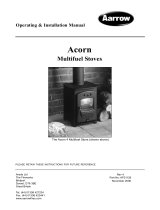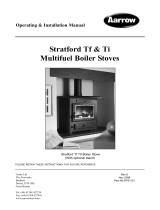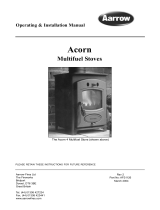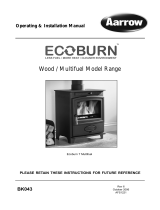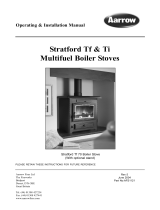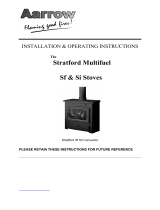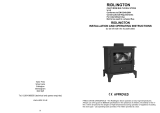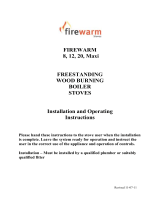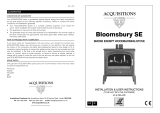Page is loading ...

Arada Ltd
The Fireworks
Bridport
Dorset, DT6 3BE
Great Britain
Tel. (44) 01308 427234
Fax. (44) 01308 423441
www.aarrowfires.com
Wood & Multifuel Stoves
Operating & Installation Manual
PLEASE RETAIN THESE INSTRUCTIONS FOR FUTURE REFERENCE
Sherborne Medium Multifuel Stove
Rev 2
Nov 2006
AFS1237
Sherborne

Congratulations on your choice of an Aarrow Stove.
More than 20 years experience has been put into the
development of our Sherborne, range to ensure
ultimate performance and years of trouble free
enjoyment.
Every detail on the stoves has been carefully
engineered and designed which is why we are so
confident in the reliability of our product that we
offer a Lifetime Guarantee.
Should you have any questions about our
Sherborne range of stoves that are not covered in
this manual, please contact the Aarrow dealer in
your area, or call our Technical support department
on
01308 427234
© COPYRIGHT 2006
Arada Ltd
This booklet has copyright & may not be
copied in whole or part or be used for any
purpose other than that for which it is
supplied without express written consent
from Arada Ltd.

INTRODUCTION Page
Safety Notices 5
The Principle of the Fire 5
Check List 6
Technical Data 7
OPERATING INSTRUCTIONS
Firebox Linings and Throat Plate Removal 8
Multifuel Grate 8
Wood Stove - Wood Tray 8
Air inlet Controls/Airwash System 8-9
Multi-Purpose Operating Tool 9
Fire Door Glass 9
Door Adjustment 10
Fuel Retainer Bars 10
Fitting the Feet 10
Fuel Types 11
Lighting The Fire 11-12
Extended Burning 12
Over Firing 13
Ash Removal 13
SERVICING
Cleaning & Annual Maintenance 13-14
Accessories 15
INSTALLATION Page
General Precautions 16
Handling 16
Hearth 16
Combustible Materials 16
Firebox Liner Panels 17
Throat Plate Inspection 17
Assembling the Multifuel Grate 18
Interchangeable Canopies 19
Flues & Chimneys 20-23
Add In Boilers/Water Connections 24-25
Final Installation Check List 26
Parts List 27-29
LIFETIME GUARANTEE
Guarantee 30
Customer Registration 30
SERVICE RECORD
Service Record 31
Final Factory Check List 32
Sherborne Wood & Multifuel Stoves 3
CONTENTS

WARNING
TO ALL MULTIFUEL USERS
PETROLEUM COKE
SOME OF WHOSE BRAND NAMES ARE
"CALCO", "PETROCOKE" OR "WONDERCO"
MUST NOT BE BURNED IN THIS APPLIANCE
TO USE THESE FUELS WILL INVALIDATE THE
APPLIANCE GUARANTEE
IF IN DOUBT CONTACT THE SOLID FUEL ASSOCIATION
TELEPHONE NUMBER 0800 600 000
www.solidfuel.co.uk
THE USE OF SPARE PARTS OTHER THAN THOSE SUPPLIED
BY AARROW FIRES LTD WILL INVALIDATE THE
APPLIANCE GUARANTEE.
4 Sherborne Wood & Multifuel Stoves

Sherborne Wood & Multifuel Stoves 5
INTRODUCTION
SAFETY
A fireguard conforming to BS 8423: 2002 should
be used in the presence of children and old/or
infirm people. If the appliance is used with the fire
door open, a spark guard conforming to BS 3248
should be fitted.
Do not use aerosol sprays or any other flame
near the appliance under fire.
Do not fit an extractor fan in the same room as
the appliance.
Fire cement is caustic, hand and eye protection
should always be worn, prolonged contact with
the skin should be avoided.
Aarrow Fires Ltd will not be responsible for any
consequential or incidental loss or injury
however caused.
Before continuing any further with the installation
of this appliance please read the following guide to
manual handling.
• Always obtain assistance when lifting the
appliance.
• When lifting always keep your back
straight. Bend your legs not your back.
• Avoid twisting at the waist. It is better to
reposition your feet.
• Avoid upper body/top heavy bending. Do not
lean forwards or sideways when
handling the fire.
• Always grip with the palms of your hands.
Do not use fingertips for support.
• Always keep the stove as close to the body as
possible. This will minimise the cantilever
action.
• Use gloves to provide additional grip.
THE PRINCIPLE OF THE FIRE
Your Aarrow Fire is built to the highest standard of
craftsmanship using the best materials and the most
modern equipment available. It is a highly efficient
and sophisticated piece of machinery and when
properly installed and operated it should provide a
lifetime of heating satisfaction.
Safety is the most important consideration when
installing your fire. If not properly installed and
operated a house fire may result. installation must
comply with the Building Regulations and conform
to all relevant fire safety standards.
Aarrow Fires produce a variety of appliances
ranging from units, which are traditional in style to
stoves which are modern in appearance, all
bristling with "High Tech" features.
Model types include simple room heaters,
convectors, integral boiler models and inset units.
Your Aarrow Fire is constructed from either single
or twin wall steel strengthened where necessary.
Cast iron is used where appropriate for decorative
features.
All fire doors are fitted with special high
temperature ceramic glass panels through which
the fire can be viewed.
Multifuel stoves are fitted with a cast iron grate to
give full multifuel facility and positive de-ashing.
All models except integral boiler models are lined
with firebricks or heat reflective panels which
ensure complete combustion and provide a good
heat store to even out fluctuations in burning.
An internal throat plate produces turbulence to
encourage secondary combustion and directs the
flue gas around the whole upper firebox before
allowing it to escape up the chimney.
On multifuel appliances the primary air for burning
enters the ash pit chamber beneath the grate,
controlled by the air inlet mechanism.
Aarrow Fires are also fitted with an "air wash" so
called because it provides a curtain of high speed
preheated air behind the glass to help keep it clean
and to provide secondary air/over draught.
The provision of two inlets on all multifuel stoves
gives a wide range of primary air/secondary air,
under draught/over draught combinations.
The optimum settings will only be established by
experience in firing the appliance, and will depend
on type of fuel, the position of the appliance in the
house, condition of chimney etc.

6 Sherborne Wood & Multifuel Stoves
CHECK LIST
11. Multifuel
riddling kit
optional
accessory
N/A
12. Instructions
1
10. Woodburning
tray
1
optional
accessory
7
Part Description
& Visual Aid
(not to scale)
Sherborne
Small
Multifuel
2
1
4. Flue spigot
1 (5”)
5. Hotplate
7. Operating tool 1
8. Rear liner
2
9. Side liners
2
N/A
Sherborne
Medium
Wood
2
1
1(5”)
1
2
2
Sherborne
Medium
Multifuel
N/A
Sherborne
Small
Wood
1 (5”)
1
2
2
9
2
1
1 (5”)
1
2
2
Sherborne
Large
Wood
N/A
2
1
1 (6”)
1
2
2
Sherborne
Large
Multifuel
11
2
1
1 (6”)
1
2
2
1 (5”)
1(5”)
1 (5”)
1 (5”)
1 (6”)
1 (6”)
1. Grate bars
2. Fuel
retainers
2
3. Throat
plate
1
6. Ashpan 1
1
1
1
1 1
1
1
optional
accessory
1
optional
accessory
optional
accessory
N/A
optional
accessory
N/A
1
1
1 1

Sherborne Wood & Multifuel Stoves 7
TECHNICAL DATA
Room Min/Max
Room Heater Only Output (kW)
1.5 - 6
TECHNICAL DATA
Sherborne
Small
Multifuel
Room Heater with Domestic Hot
Water with add in boiler type
8
Max Output to Room (kW)
Max Output to Water (kW)
Height (mm)
505
Width (mm)
Depth (mm)
Height to Centre of Rear Flue
Depth from Back to Centre of
Flue (mm)
Flue Diameter
127 (5”)
Weight Packed (Kg)
2 - 8
Sherborne
Medium
Wood
9
127 (5”)
Sherborne
Medium
Multifuel
1.5 - 6
Sherborne
Small
Wood
8
395
127 (5”)
2 - 8
127 (5”)
Sherborne
Large
Multifuel
2.5 - 11
152 (6”)
Sherborne
Large
Wood
2.5 - 11
152 (6”)
505
3.8
2.2
3.8
2.2
5.7
2.3
490
400
103
65 Kg
490
395
400
103
68 Kg
525
590
395
415
105
77 Kg
9
5.7
2.3
525
590
395
415
105
80 Kg
10
141
430430
475475
7.6
3.4
7.6
3.4
10
106 Kg
99 Kg
141
545 545
670
670

FIREBOX LININGS & THROAT
PLATE
The Sherborne range of Wood and Multifuel stoves
firebox have reflective liners to the sides and rear
and a specially shaped throat plate which sits on the
liners. If these are not in place please refer to page
17 to install these.
MULTIFUEL GRATE
The Aarrow Multifuel grate comprises of a series of
reciprocating cast iron bars seated on a pivoted
"comb". These should come fitted in your stove, if
not please refer to page 18 for fitting and operation
and also operating instructions on fuels for correct
settings of the grate. The multifuel grate is fully
interchangeable with the wood burning tray if you
prefer to burn wood only.
WOOD STOVE - WOOD TRAY
The wood burning tray should come fitted in your
stove, if not please follow these instructions;
place
the wood burning tray inside the fire, locating
the rear lugs into the slots at the rear of both of
the side landings. Then lower the front of the
tray onto the front brace section of the fire (See
Fig.1)
Fig. 1
AIR INLET CONTROLS
Sherborne multifuel stoves have two air inlets:
•The air wash system (so called because its
pre-heated high speed air washes across the inner
face of the door glass, keeping it clear), which
provides over draught, and
•The primary air inlet providing under draught to
the base of the fire chamber through the controls on
the doors of the fires.
PRIMARY AIR FOR SHERBORNE
On the Sherborne, primary air enters the appliance
through the controls on the bottom of the fire
door(s). Moving the control knobs to the right will
increase the air inlet, to the left to reduce the air
inlet, or to seal the ash door completely.
AARROW AIRWASH SYSTEM
The air wash has an internal sliding plate with slots,
housed in a cover plate, and is located above the fire
door. Sliding the control knob to the right as far as it
will go achieves the fully open position. Sliding it to
the left will shut off the air inlet slots as shown in
Fig. 2 and Fig. 3.
Even when all the slots are completely shut a
"bleed" of secondary air will be maintained
ensuring that inflammable gases are burnt off.
DISASSEMBLE AIRWASH
The air wash may be disassembled for cleaning or
adjustment. To achieve this, the following
procedure should be followed:
This should only be carried out when the fire is cold
and unlit.
•Unscrew (Anti-clockwise) the airwash spring
handle (Fig. 4a).
•Move cover up by tapping each end of the front
cover.
•Lift cover free from body, being careful to not
damage the ends of each lug on the cover (Fig. 4b).
•Unscrew the inner slider and clean/replace
(Fig.4c).
•Refit using the reverse of this procedure.
Fig. 4a Disassemble airwash
8 Sherborne Wood & Multifuel Stoves
OPERATING INSTRUCTIONS
Fig. 2 Fully closed
Fig. 3 Fully open

Fig. 4b Lifting cover from body of stove
Fig. 4c Unscrewing
MULTI - PURPOSE OPERATING
TOOL
Your Aarrow fire comes with a multi-purpose tool,
which is used for riddling, setting the multifuel
grate position. Use the operating tool for setting the
grate in the coal burning position or the wood
burning position. This lever is also used for
de-ashing and riddling see page 13 (multifuel
stoves only) and for emptying the ash pan. (Fig. 5)
Fig. 5 Operating tool and ashpan
FIRE DOOR GLASS
In the event of the door glass being broken it can
easily be replaced. This should be done when the
appliance is cold and unlit:
•The door(s) should be lifted off the hinges so that
the below operations can be carried out on a
workbench or similar level surface.
•Unscrew the two nuts, on the inside of the door
securing the retaining clips.
•Carefully remove any pieces of broken glass, and
sealing gasket wearing suitable gloves.
•Re-place the gaskets and line them up in
relation to the door frame. (Fig.6)
Fig. 6 Lining up the gasket
•Re-seat the new glass, ensuring the sealing gasket
is flat and in contact with the glass. (Fig.7)
Fig. 7 Fitting door glass
•Replace the two retaining clips and nuts. Do not
over-tighten the nuts as damage may occur to the
glass (Fig.8) Re-place the door(s) carefully over
the hinges and slot in place.
Fig. 8 Tightening glass clips
Sherborne Wood & Multifuel Stoves 9
OPERATING INSTRUCTIONS

DOOR ADJUSTMENT
Once the appliance has been under fire for a period
of time the fire door may appear to have moved out
of alignment with relation to the door aperture. This
is quite normal and due to the settling of the casing.
The fire door can be re-aligned by the user as
follows:
•When the appliance is cold, open the fire door so
that it is at a right angle to the front face of the fire.
•Lift the fire door up off the hinges.
•Gently tap the two hinge pins in a direction to
compensate for the misalignment.(Fig. 9)
•Refit the door and check to ensure it now sits
square to the body; if not repeat above steps.
Fig. 9 Adjusting the Sherborne hinges
FUEL RETAINER BARS
Fuel retainer bars are supplied with the fire. Slide
and lift the bar until it is clear of the guides at each
side, and remove through the fire door opening.
The bars are symmetrical and of even lengths
making incorrect fitting impossible.
Note: This operation should only be carried out
when the appliance is cold and unlit.
10 Sherborne Wood & Multifuel Stoves
OPERATING INSTRUCTIONS

FUEL TYPES
Wood- Any type of wood is suitable provided it is
well seasoned and has a moisture content below
20%. This usually implies that the timber has been
suitably stored to allow moisture to evaporate for at
least nine months in the case of soft woods, and at
least eighteen months in the case of hard wood. We
recommend that for general burning, wood should
be split into logs of no more than 130mm (5")
diameter.
Larger logs can be used for overnight burning.
WARNING wet wood must not be used as this will
greatly contribute to the creation of tar and creosote
which may, in extreme cases, run down the
chimney in liquid form. This will seriously damage
both the chimney and the appliance, and increase
the risk of chimney fire.
Note: If you have sticky tar inside the appliance or
chimney your wood is 'Green' or too wet.
Recommended Reading:
"Wood as Fuel" available from the Forestry
Commission.
Peat- Can be used in turf or briquette form, but
again the moisture content must be low.
Paper- paper will burn successfully. Burn dry
paper only or chimney damage will occur.
NEVER BURN PLASTICS OR WASTE IN
YOUR STOVE.
Coal -
Household coal produces a large amount of
ash and smoke. If used the appliance and chimney
will require frequent cleaning. Therefore soft house
coal is not
recommended.
Recommended fuels are as follows:
The Hetas Ltd, "Three Tick" appliance approval
only covers the use of the following fuels in this
appliance; Phurnacite, Phurnacite Plus,
Centurion, Maxibrite, Extracite, Pureheat,
Blazebrite, Taybrite, Sunbrite (Doubles/Singles),
Anthracite (Large Nuts), and Welsh Dry Steam
Coal (Large/Small Nuts).
Approval does not cover the use of other fuels
either alone or mixed with the suitable fuels listed
above, nor does it cover instructions for the use of
other fuels.For latest details please refer to Hetas
website www.hetas.co.uk.
Do not use smaller sizes than Stovesse, e.g.
Beans, Peas,Grains.
Do not use petroleum based solid products such
as Calco or Petrocoke.
To do so will invalidate
the appliance guarantee
LIGHTING THE FIRE
Prior to lighting the fire for the first time check
with the installer that:
•Installation and all building work is complete.
•The chimney is sound and has been swept and is
free from obstruction.
•Adequate provision for combustion air has
been made, i.e. a permanent vent of at least
550mm² per kW of rated output above 5 kW,
is fitted in the room in which the appliance
is installed.
•That Building Regulations and any local
by-laws have been followed during installation
(see installation instructions).
•All firebox liner panels are in place.
•Throat plate is in place.
•Where add in boilers are fitted ensure that the
system is full of water and vented, and
precautions have been taken to prevent corrosion
(see installation Instructions).
•That the chimney draw has been checked and is
within specification. With the chimney warm the
draught should be between 1 - 2mm water gauge
(0.1 - 0.2mbar).
WARNING: An over drawing chimney can cause
over-firing resulting in damage to the appliance.
WARNING - ADD IN BOILERS: Do not light the
fire if it is suspected that any part of the water
system is frozen.
Sherborne Wood & Multifuel Stoves 11
OPERATING INSTRUCTIONS

ENSURE THAT YOU HAVE READ &
UNDERSTOOD THESE INSTRUCTIONS
BEFORE LIGHTING THE FIRE.
ALWAYS WEAR SUITABLE PROTECTIVE
FIRE GLOVES WHEN REFUELLING YOUR
STOVE.
SOLID FUEL BURNING
•Set the grate to ‘coal’ position.
•Ensure that the ash pan is in position and the fire
doors are closed.
•Set the air wash to one quarter open position.
•Set the primary inlet to the fully open position
•Light in the normal manner with paper and
kindling, or use a fire lighter.
•If using a gas poker be sure to remove it
immediately the fire is alight.
•When the fire is well alight regulate the burning
rate by adjusting the setting on the primary air
inlet control.
•The air wash can be opened sufficiently to keep
the door glass clean
BURNING WOOD
•When burning wood on multifuel version set to
grate to wood burning position.
•If wood burning only version no further settings
are required.
•Set air wash to fully open position.
•Proceed as for solid fuel but note the fire will burn
up and become established more quickly.
• Ensure primary air control is in the fully closed
position. Note some familiarisation may be
required due to fuel variation and some adjustment
may be necessary.
MIXED FUELS (Multifuel Version Only)
•The grate can be set to either coal or wood
position depending on the main percentage of
the fuel to be burnt.
•As per coal but allow additional secondary air.
•The primary air inlet can be closed and burning
regulated by means of the air wash above the door.
ANTHRACITE (Multifuel Version Only)
Anthracite is more difficult to keep in for long
periods, consequently more care in setting the
controls and some familiarisation is necessary
when burning anthracite.
Use the smallest size fuel (Stovesse or Small Nuts).
Proceed as for manufactured smokeless fuel. Leave
the air inlet control open about a quarter or less.
Note: The high temperature paint acquires
durability by being "cured" during the initial
firings of the appliance will give off fumes which
are non-toxic, but which certain persons may find
have an unpleasant or irritant effect. Ensure that
the area is well ventilated during this time.
EXTENDED BURNING
The appliance will burn for an extended period
provided:
•Sufficient fuel is placed in the firebox.
•The controls are set correctly.
•Excess draught is not present in the chimney.
•Close the door.
•If the fire goes out with unburnt fuel left in the
firebox increase the air opening slightly, & vice
versa.
In the morning
Open the air control fully until embers begin to
glow brightly and place pieces of fuel on the fire
until it is well established.
WARNING: When wood is burnt slowly in a
closed appliance it produces moisture and tar,
which will create condensation and deposits in the
chimney. This effect can be minimised by burning
hard for a short period, about 20 minutes, twice a day.
It is usually convenient to do this morning and night.
Note: To avoid chimney problems your fire should
not be burnt slowly for longer than 12 hours
without a period of fast burning.
WARNING: Properly installed, with a suitable
flue and chimney and operated and maintained
this appliance will not emit fumes into the
dwelling. Occasional fumes from the de-ashing
and re-fuelling may occur. However, persistent
fume emission is potentially dangerous and must
be investigated by a Hetas registered installer.
Stop using the appliance if you smell fumes or
see smoke escaping.
If fume emission does persist, the following
immediate actions should be taken.
• Open doors and windows to ventilate room.
• Let the fire die or extinguish and safely dispose of
fuel from the appliance.
12 Sherborne Wood & Multifuel Stoves
OPERATING INSTRUCTIONS

• Check for flue or chimney blockage, and clean if
required.
Seek expert advice from your HETAS registered
installer. Do not attempt to re-light the fire until the
cause of the fume emission has been identified and
corrected.
ASH REMOVAL - Wood burner only
Ash will drop through the holes and to the slides of
the specially designed wood tray. This should be
removed from the stove periodically. It is advisable
to leave a layer of ash on the wood tray to prolong
its life and maintain optimum conditions for
burning wood.
ASH REMOVAL - Multifuel Stoves only
The ash pan should be emptied at least twice a day
or when the level of ash reaches the top of the ash
pan. On no account should the ash be allowed to
build up to touch the grate as this will greatly
shorten its life.
DE - ASHING - Multifuel Stoves only
It is necessary to maintain an ash layer on the upper
surface of the grate bars, in order to protect them so
de-ashing should cease as soon as the first red
embers drop into the ash pan. Further de-ashing
will cause heat build-up under the grate, which will
considerably shorten its life. This operation should
be carried out with the doors closed to prevent dust
escaping into the room.
•Move up and down vigorously the riddling
lever (ash will fall into the ash pan beneath
the grate).
•When de-ashing is complete re-set grate to
previous position.
• Empty the ash pan.
Note: Do not force the riddling lever.
TO EMPTY THE ASH PAN
Open the fire door. Fit the fork end of the operating
tool into the ash pan and remove from the ash
chamber.
WARNING: The ash can be very hot. Empty only
to a metal container. Even if the ash appears cold,
red-hot pieces of ash may be concealed and could
easily start a fire or cause an injury. Replace the ash
pan and close the fire door.
CLINKER
The formation of clinker suggests that the unit is
being over-fired. Any clinker forming on the grate
should be removed when cold.
OVER-FIRING
Do not over fire your appliance. Using flammable
liquids or too much wood or firing the fire at
maximum for prolonged periods may result in
over-firing. If the chimney connector or casing
glows red it is being over-fired. If this occurs
immediately close all air inlets to the appliance to
reduce the air supply to the fire. Should a chimney
fire occur immediately close the appliance down.
Get everyone out of the house and call the fire
brigade. A chimney fire may cause structural
damage of the chimney. Do not use the appliance
until the chimney and connector have been
inspected and any damaged parts repaired or
replaced. This should be done by a competent person
such as a HETAS registered engineer.
CLEANING
IMPORTANT
Under some circumstances soot can quickly build
up on the throat plate and adjacent areas. The throat
plate should be removed and checked monthly, and
any debris stripped off. Similarly, clean the upper
surface of the firebox.
Refer to page 17 for instructions on throat plate
removal/inspection.
ANNUAL MAINTENANCE
It is important that your fire is regularly serviced in
accordance with these instructions. This should be
carried out at least annually by a qualified person
and should consist of the following.
Please ensure that your fire is left clean and moving
components are well lubricated for the summer
(during periods of prolonged non-use). If possible
store the throat plate outside the fire, check all
moveable components, at regular intervals, to
ensure they are moving freely. Allowing the
maximum air movement through the fire. This
should ensure it stays in the best condition for the
coming winter months.
Sherborne Wood & Multifuel Stoves 13
OPERATING INSTRUCTIONS

Remove the firebricks lining and throat plate,
inspect all gasketing on doors, glass etc., and
re-order any items that may need replacing, from
your Aarrow dealer. With a wire brush clean inside
the appliance paying particular attention to the
small inlet holes of the air wash on the inside,
above the fire door and to the door.
Sweep the chimney and confirm that it is sound.
Examine all joints in the flue pipe etc., and re-seal
if necessary. Reassemble and leave with the air
inlet and air wash control about half way open. This
will allow a free flow of air through the appliance
thus preventing moisture and condensation from
building up inside the fire and chimney.
CHIMNEY SWEEPING
Sweeping should be carried out with an appropriate
sized bristle brush and rods to suit chimney size and
type. As with all appliances regular sweeping of the flue
is essential to avoid the danger of blockage and the
escape of poisonous fumes. Access for cleaning should
also be incorporated in the chimney (e.g. soot door or
access through register plate).
Any existing chimney should be swept prior to
installation of the appliance, and swept again a
second time within one month of regular use after
installation to establish frequency of sweeping
required. This should be done by a competent
person such as a NACS chimney engineer who will
provide a Certificate of Chimney Sweeping.
Sweep the whole flue way, including the outlet, at
least twice per burning season. It is important that
the flue ways, flue pipe and chimney be cleaned
prior to lighting the fire after a prolonged
shut-down period.
DOOR GLASS
The door glass should remain clear during normal
daytime burning. However under certain conditions-such
as burning at a low rate with damp wood, or overnight
burning, the glass may become somewhat blackened. To
remedy this, operate the appliance at a fast rate.
Alternatively when the stove is cold open the door and
clean the inside face of the glass with a damp cloth or
with glass cleaner (available from fire stockists). A piece
of cloth moistened with vinegar and dipped in wood ash
- not coal ash - will provide a good soft scourer to
remove the soot without scratching the glass.
OUTER FINISH
The outside finish of the appliance is a durable high
temperature paint. It is best cleaned by brushing
down with a clean shoe brush. Do not allow
moisture to remain on the appliance whilst cold or
surface rust may form.
The high temperature paint should not require
attention for some time, depending on use. The
hotter the fire burns the sooner repainting will be
necessary. Aerosol tins of paint are available for
complete refurbishing. Before repainting make sure
that the fire is out and is cold.
•Remove the door glass.
•Lightly wire brush, or rub with wire wool, the
body of the appliance to remove any loose paint
powder.
•Mask or remove items such as brass work.
•Any adjacent brickwork, mantelpiece, hearth,
etc., should be carefully masked for quite a
distance around the appliance. (this precaution is
to prevent discolouration of the surrounding brick
work, wallpaper etc).
Re-spray in a well-ventilated area - avoid breathing
the vapour. Refer to safety instructions on paint
cans.
•When the paint is dry refit door glass and any
other parts previously removed.
•Leave the appliance for eight hours before
re-lighting.
•Burn slowly for the first four hours, then build up
heat gradually to cure the paint.
Note: Use only genuine Aarrow touch-up spray as
some paints interact. This could ruin the finish
and invalidate the guarantee.
14 Sherborne Wood & Multifuel Stoves
SERVICING

Sherborne Wood & Multifuel Stoves 15
ACCESSORIES
ACCESSORIES
WOOD BURNING TRAYS
To turn your multifuel stove into a dedicated woodburner. As shown in Fig. 10a below
MULTIFUEL UPGRADE KIT
Available for the wood burning range to enable you to burn solid fuel in your Sherborne woodburning stove.
(See Fig. 10b)
ADD IN BOILERS
See page 24 for further instructions on add in boilers.
PAINT
Matching aerosol paint to tone in any connecting flues, pipes or surrounding metalwork.
TRACERIES Please note traceries will be available at a later date.
ADD ON CANOPIES Option of low or high canopies. Please refer to page 19 for fitting instructions.
Fig. 10a
Fig. 10b
ADD IN BOILER
TECHNICAL DATA
Sherborne
Small
Wood & Multifuel
Room Heater with Domestic Hot
Water with add in boiler type
8
Max Output to Room (kW)
Max Output to Water (kW)
3.8
2.2
Sherborne
Medium
Wood & Multifuel
9
5.7
2.3
10
7.6
3.4
Sherborne
Large
Wood & Multifuel

16 Sherborne Wood & Multifuel Stoves
INSTALLATION
GENERAL PRECAUTIONS
Note - All installations must conform to the
appropriate building regulations.
The Building Regulations for England and Wales
2000 ref Approved Document J 2002 edition
(issued by the DTLR).
The Building Standards (Scotland) (Consolidation)
Regulations.
Detailed recommendations for installation of
appliances, chimneys and flues are outlined in the
current issue of the following British Standards:-
BS6461, BS8303 and BS4543.
Any Manufacturer's Instructions must not be
taken as overriding statutory requirements.
During installation ensure that adequate
precautions are taken to avoid unnecessary risk to
yourself or any householder. In particular the
danger from the caustic nature of the fire cement
should be avoided by using these accepted
methods:
• Wear gloves when handling fire cement.
• Wear goggles when chiselling or looking up
chimneys.
Make sure that Building Regulations are adhered to
during installation along with any local by-laws. In
the case of heating systems make sure that the pipe
work is correctly bonded to ensure electrical
earthing.
HANDLING
By the time you read this you will appreciate the
weight of the appliance. The Safety and handling
guidelines as set out on page 5 of this manual
should be followed.
To make movement easier internal fittings, fuel
retainers, grates, firebox liners, flue outlets, hot
plate, throat plate, etc., can be removed.
Care should be taken to make sure that the hinges
are not damaged during installation.
HEARTH
The fire should be installed to stand on a
constructional hearth of non-combustible materials
not less than 125mm (5'') thick conforming to
Building Regulations. Dimensions of the hearth
should project at least 300mm (12'') forward of the
front of the appliance and 150mm (6'') at the sides.
The surface of the hearth should be free of
combustible materials. In most buildings with solid
concrete floors the requirement will be met by the
floor itself, but mark the perimeter of the hearth to
ensure floor coverings are kept well away or use
different levels to mark the hearth perimeter.
COMBUSTIBLE MATERIALS
A gap of at least 450mm (18'') should be allowed
between the appliance and any combustible
materials including furnishings. Adjacent walls
should be of suitable non-combustible
construction, preferably brickwork. In large
fireplaces take care that any supporting beam is
protected by a 13mm (0.5'') sheet of
Masterboard/Supalux spaced 13mm (0.5'') off the
surface with strips of non-combustible material
- not wood.
Make sure that there is a gap between an
uninsulated flue system and any combustible
material. This gap must be at least 3 x the outside
diameter of the flue pipe, or 1.5 x the flue diameter
to non combustible surfaces. see illustration p22.
AIR FOR COMBUSTION
There must always be a permanent means of
providing air for combustion into the room in
which the fire is installed. A permanent vent with a
total free area of at least 550mm
2
for every kW
rated output above 5kw should be connected
directly to the outside air or to an adjacent room
which itself has a permanent vent of the same size
direct to the outside air. The fitting of an extractor
fan to either of these rooms is not recommended.

Sherborne Wood & Multifuel Stoves 17
INSTALLATION
FIREBOX LINER PANELS
The Sherborne Wood and Multifuel stoves use
reflective liners to the sides and back. The throat
plate sits on top of the side and rear panels. These
should come fitted to your fire, if however they are
not proceed as follows to fit them.
•Remove the front fuel bars.
•Set the small liners into the back of the fire.
•Insert side liner panels
•Fit the throat plate with the single bend and two
cut outs to the front facing up. The projecting lugs
sit on top of the side liners. The long centre tab on
the back edge rests on the rear liners. The shorter
turn-down tabs against the vertical face.
•Replace the front fuel retainer bars.
Note: Neither the rear firebox liners nor the side
firebox liners are "handed", both faces are
suitable for direct contact with the fire.
Note: Cracking of lining panels does not effect
efficiency.
Fig. 11 Sherborne Medium Multifuel liners
and throat plate.
Fig. 12 Liners inserted in Sherborne
Medium Multifuel.
Fig. 13 Inserting Throat Plate in to
Sherborne Medium Multifuel.
Fig. 14 Liners, throat plate and grate in
Sherborne Medium multifuel.
REMOVAL OF THE THROAT PLATE
Blocked chimneys cause dangerous fumes to
escape. Remove throat plate at least monthly to
clean. Keep chimney and flue ways clear.

MULTIFUEL GRATE
GRATE
The grates in the Sherborne Multifuel units
comprise a series of reciprocating cast iron bars
seated on a pivoted "comb". All bars in the grate are
identical, but every other bar is turned through 180
degrees, with the ends of the bars marked "H" sit-
ting on the high sections of the comb, and the ends
marked "L" sitting on the low sections.
ASSEMBLING THE GRATE
To assemble the grate, fit bars to low sections of the
comb first, inserting end marked "H" into rear
channel with groove on underside of bar located on
upstand tab, and then lowering end marked "L"
onto the low section of the comb. The upper bar is
fitted in a similar manner, but with the end marked
"L" inserted in the rear channel, and the end
marked "H" seated on the high section of the comb.
GRATE BAR REPLACEMENT
After extended use it may be necessary to replace
some of the grate bars. Periodic inspection of the
bars is recommended and the removal of any nails
or wire that may be present after burning wood.
All the grate bars in each appliance are identical
and can easily be lifted out after removal of the fuel
retainers. Remove damaged grate bars and replace
with casting of the same type, fitting as per
instruction above. (Check Identification letters on
the casting when reordering).
18 Sherborne Wood & Multifuel Stoves
INSTALLATION

INTERCHANGEABLE CANOPIES
The canopy versions for the Sherborne range
are slab top stoves to which a low or high canopy
can be fitted after installation and are
interchangeable.
These are fitted as follows:
•To fit the interchangeable canopy (Fig 10c):
•Remove the front clamps.
•Tilt the canopy as shown in stage 1.
•Engage the rear clips and pull fully forward.
•Fit the front clamps and tighten.
•Fit the required blanking plates shown in stage 2.
Sherborne Wood & Multifuel Stoves 19
INSTALLATION
Fig. 10c

20 Sherborne Wood & Multifuel Stoves
INSTALLATION
FITTING THE FLUE OUTLET AND
HOT PLATE
The flue outlet spigot is found inside the appliance.
The hot plate (blanking plate) is supplied fitted to
the top opening and is removed by turning
clockwise (as is the flue outlet).
Smear a very thin layer of fire cement on the faces
of the flue outlet and the blanking plate. Fit the
outlet to the appliance in the desired position.
Lock into place by rotating anti-clockwise and
tighten by tapping with a block of wood and mallet
from the inside of the appliance. Similarly, fit the
blanking plate to the unused opening. Clean off any
surplus fire cement.
Place appliance on the hearth and make sure that it
is level and does not rock.
Connect the chimney ensuring all joints are sealed
with fire cement.
Fig. 15 Flue and Spigot Fitting
FLUES AND CHIMNEYS
Please remember that chimney draught is
dependent on four main factors:
• Flue gas temperature.
• Flue height.
• Flue size.
• Flue terminal.
The stove must be connected to a suitable and
efficient flue that provides a good updraught to
safely take the products of combustion (fumes)
from the stove outlet to the outside air. To ensure a
good updraught it is important that the flue gases
are kept warm and that the flue size suits the stove.
The termination of the outlet at the top of the flue
also needs to comply with the Building
Regulations. The minimum effective height of the
flue must be at least 4.5 metres from the top of the
stove to the top of the flue outlet. When warm the
flue draught should be between 0.1 and 0.2 mb.
A chimney may comply with the regulations but
still be subject to down draught and similar
problems. A chimney terminating above the ridge
level is generally less likely to suffer such
problems.
If a new chimney is being provided it should fully
comply with the relevant Building Regulations that
specify the requirements for solid fuel burning
installations. Suitable types of chimney include the
following.
Masonry chimney built with clay or concrete
liners, or a chimney block system meeting Building
Regulations. These types of chimney should be
installed in accordance with the Building
Regulations and BS 6461: Part 1.
Factory made insulated chimney complying
with BS 4543: Part 2 (often called "Class 1
prefabricated metal chimney"). These types of
chimney should be installed in accordance with the
Building Regulations and BS 7566: Parts 1 to 4.
/
